Japan
Wood Products Prices
Dollar Exchange Rates of 10th
May
2019
Japan Yen 109.34
Reports From Japan
¡¡
Survey ¨C economy worsening for the
first time in six
years
A government survey during the first quarter 2019 shows
the Japanese economy ¡°worsening¡± for the first time in
more than six years reinforcing the view that Japan may
have entered a recession in the first quarter 2019. This
calls into question the wisdom of raising the consumption
tax in October.
The main economic indicators indicate that risks to
exports due to the US/China trade war and weak domestic
demand undermined business confidence and investment
plans. Exports are estimated to have declined by 1.5% and
capital spending by 1.8%.
Private consumption, which was supporting the economy,
also fell. Worries are also mounting that the US/China
trade war will further affect the Japanese economy and
that the US may take a tough stance on its trade talks with
Japan.
Private consumption falls and risks to economy grow
Following the disappointing economic performance in the
third and final quarters last year, it appears that private
consumption weakened in the first quarter of 2019.
The second half 2018 decline was put down to the
combined impact of a series of natural disasters and a drop
in exports especially to China but the overall decline was
tempered as private consumption held up. This changed in
the first quarter when private consumption fell and this
was felt by importers.
It remains to be seen if the increased government spending
and the up-beat mood of consumers as they welcomed the
new Reiwa Era has boosted spending. But the consensus
amongst analyst is that the far greater risk for the Japanese
economy is the escalating trade friction between the US
and China.
When global tensions rise there is the usual flight of
foreign currency to the Yen and already the Yen has
appreciated against the US dollar, bad news for Japan¡¯s
exporters.
If predictions of a contraction in growth in the first quarter
2019 are proven correct it is likely there will be calls for a
delay in the consumption tax hike scheduled for later this
year.
3 year low for consumer confidence
The April Consumer Confidence Survey conducted by the
Cabinet Office shows consumer confidence declined to the
lowest level in more than three years. The overall index
fell to 40.4 in April from 40.5 in March. This put the April
index at the lowest since February 2016.
Among the other indices, the index reflecting households¡¯
inclination to buy durable consumer goods declined in
April along with those measuring expectations on
employment, livelihood and income growth.
See: https://www.esri.cao.go.jp/en/stat/shouhi/shouhi-e.html
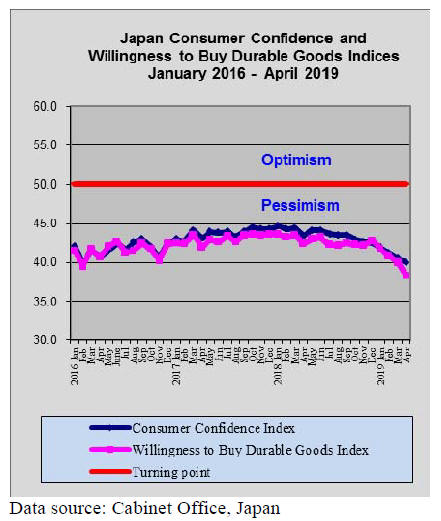
Global uncertainty - a rush to Yen
Amid escalating trade tensions between the US and China
the Japanese currency appreciated against the US dollar
with the US$/Yen falling to around 109 on 10 May.
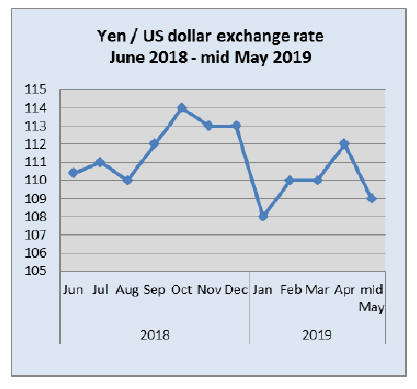
Millions discovered as old homes demolished
The latest housing survey from the Ministry of Internal
Affairs and Communications says that in 2018 the number
of homes in Japan increased by 1.8 million to 62.4 million
of which 53.7 million or about 86% were occupied at the
time of the survey. Of the remaining 14% a large
proportion of these were classified as abandoned.
The owners of abandoned and dangerous old houses are
required to demolish these structures and when owners
cannot be located the authorities will undertake the work.
The domestic press reports that it is not uncommon, during
the demolition, for hidden cash to be found. Apparently,
around Yen 600 million of hidden cash was found and
handed to the Tokyo Metropolitan Government last year.
https://www.stuff.co.nz/life-style/homed/latest/112493313/whyare-
so-many-houses-sitting-empty-in-japan

Import update
Wooden door imports
Year on year, the value of Japan¡¯s March wooden door
imports rose 26% and compared to the value of imports in
February there was a 5% jump in March. First quarter
2019 imports of wooden doors were 6% higher than in the
same period in 2018.
In March the top shippers of wooden doors to Japan were
China, the Philippines and Indonesia. China accounted for
60% of March imports of wooden doors followed by the
Philippines (22%) and Indonesia.
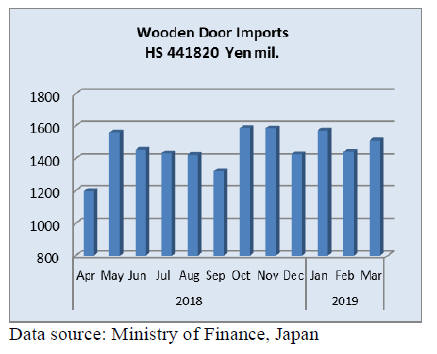
Wooden window imports
Following the year on year decline in the value of wooden
window imports in February, March year on year imports
continued down, falling 11%. However there was a slight
up-tick in the month on month imports (+8%). First
quarter 2019 imports of wooden windows were little
changed from a year earlier.
Some 70% of Japan¡¯s March imports of wooden windows
were supplied by China (41%) and the US (33%).
Shipments from Sweden contributed another 2-3% with
the balance being shipped from mainly manufacturers in
the EU.
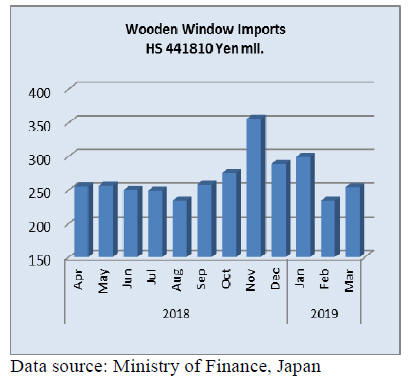
Assembled wooden flooring imports
The value of assembled flooring imports nosedived in
February and the downward trend extended into March
with year on year imports dropping a further 26%. The
month on month trend was no better with an over 25%
decline recorded.
March imports of wooden flooring were predominately of
HS441875 which was 97% of all categories of wooden
flooring imports. March imports were dominated by
shippers in two countries, Indonesia and China.
Shipments from Indonesia accounted for 46% of all March
imports of wooden flooring and shipments from China
added a further 44%. In previous months shipments from
Thailand were significant but this was not so in March.
First quarter 2019 imports of assembled flooring were
15% below that in the first quarter 2018.
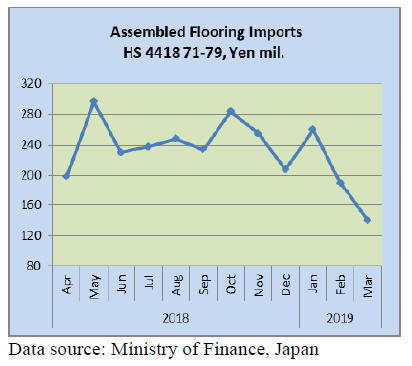
Plywood imports
Japan¡¯s March 2019 plywood imports dropped below
150,000 cubic metres, a record low. Plywood demand
remains firm and more of the domestic demand is being
met from domestic production from domestic raw
materials as well as imported veneer. Year on year March
import volumes were 13% down and month on month
March imports fell a massive 24%.
Compared to the first quarter of 2018 plywood imports fell
6% in the first quarter of 2019.
As usual, the top three suppliers Malaysia, Indonesia and
China continued to dominate plywood imports but all
three saw March shipments drop.
Shipments from Malaysia and Indonesia, the two biggest
suppliers, fell 26% year on year in March 2019 and
shipments from China were also down 10% year on year.
More startling was the month on month shipments from all
three main suppliers with China witnessing a 60% decline
only just beating the 64% decline in shipments from
Vietnam which was beginning to gain market share.
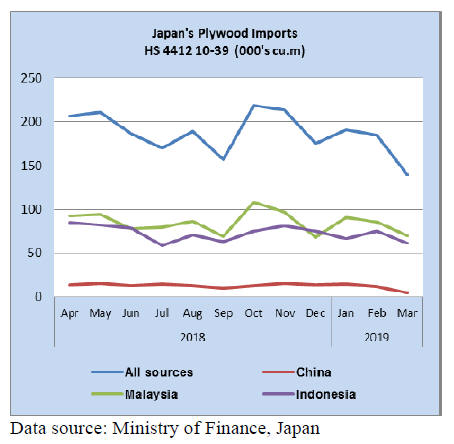
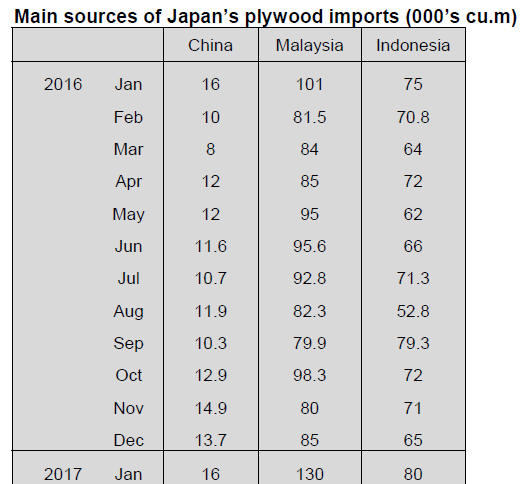 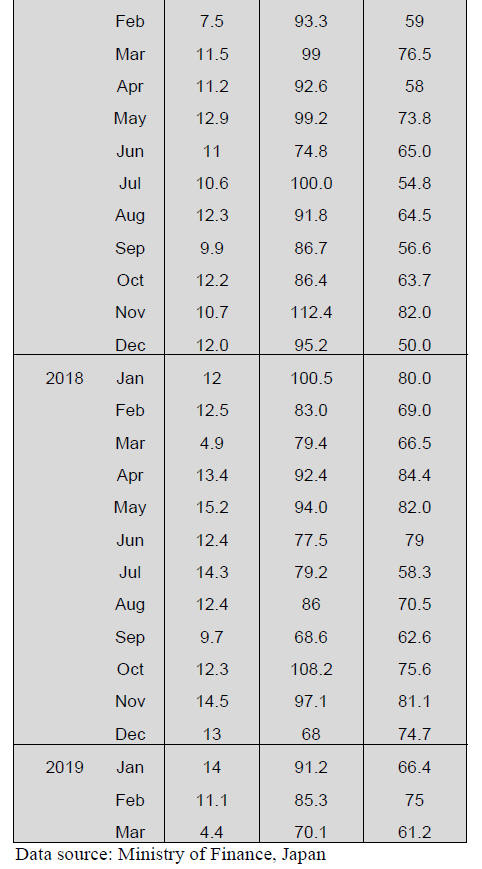
Trade news from the Japan Lumber Reports
(JLR)
The Japan Lumber Reports (JLR), a subscription trade
journal published every two weeks in English, is
generously allowing the ITTO Tropical Timber Market
Report to reproduce news on the Japanese market
precisely as it appears in the JLR.
For the JLR report please see:
http://www.nmokuzai.
com/modules/general/index.php?id=7
Increasing imports of veneer
Import of South Sea hardwood veneer for manufacturing
plywood has been increasing since second half of 2018.
Import of veneer from Malaysia and Indonesia in
November 2018 was over 2 million square metres and the
import in February 2019 was almost the same.
After Sabah, Malaysia banned log export since May 2018,
log supply shifted to PNG and at the same time, import of
veneer from Malaysia and Indonesia increased to
supplement short supply of tropical hardwood logs.
Tropical hardwood log import in 2018 was 153,407 cbms,
4.5% more than 2017 out of which logs from PNG were
76,394 cbms, 164.5% more.
This is about a half of total log import. Logs from Sabah
dropped by about 50% with about 37,000 cbms. Logs from
Sarawak were about 40,000 cbms, slight drop from 2017.
After Sabah¡¯s log export ban, log import was expected to
drop sharply but PNG increased to fill the gap.
Japanese hardwood plywood manufacturers have been
testing many species from various sources and at the same
time, they increase using hardwood veneer from Malaysia
and Indonesia. Some trading firm has established
supplying 10 containers of veneer a month (about 800
cbms in log base).
Total veneer import in 2017 was 11,000,000 square metres
then that in 2018 was 13,000,000 square metres. The
import for January and February in 2019 was 3,520,000
square metres, which is more than one fourth of total
import of 2018.
South Sea (tropical) logs
Log market prices in Japan on both Malaysian and PNG
are firm. Log importers are asking Malaysian log suppliers
not to increase log prices any more as further increase lose
log market in Japan.
Malaysian log suppliers are facing increase of minimum
wage and harvest tax Log import this year has been stable
mainly from PNG but future is uncertain as there are
rumors that Sarawak, Malaysia may reduce log export
quota from present 20% in summer and may stop export
eventually. With Sabah continuing log export ban and if
Sarawak stops log export, PNG is the only source left.
Japanese plywood mills increase import of hardwood
veneer to supplement log shortage.
Wood demand projection by Forestry Agency
The Forestry Agency held demand projection meeting in
March 22. There are different opinions for rush-in demand
before the consumption tax hike in October by source and
item.
With such expectation, there may be oversupply by startup
of new plywood plants and import products.
Projection of new housing starts by 12 private think tanks
is 920,000 units in 2019 and 880,000 units in 2020.
Domestic log demand for lumber manufacturing for the
second quarter would decline but increase for third
quarter.
Log demand for plywood will increase with three new
plants including LVL starting up. Domestic log export in
January decreased for three major markets of China, Korea
and Taiwan. Particularly export for China dropped by
34.8% from January 2018.
North American log demand may decrease after the
second largest Douglas fir cutting sawmill, Toa quit last
year and competition with others like European laminated
lumber gets severe.
Demand for North American lumber for the second and
third quarter decreases compared to 2018.
For European lumber for the second and third quarter,
depressed redwood laminated lumber may recover some
but inventory adjustment is priority matter. Import of
redwood lumber keeps declining while domestic laminated
lumber mills will increase production toward fall demand.
Plywood demand now is pausing but is expected to
recover after holidays in early May while the supply of
softwood plywood will increase by start-up of new plants.
Imported plywood orders will decline for the second
quarter with ample inventories but will increase in the
third quarter after the inventories decline. Radiata pine
logs and lumber import will decrease after April due to
demand slow period of crating lumber.
Tropical hardwood lumber import in 2018
Import of laminated free board in 2018 was about 10%
less than 2017 because the demand in Japan stagnated and
the inventories stayed high and the prices were down.
Meantime, on the supply side, the cost increased by higher
planted species and investment to deal with environmental
problems so the orders from Japan dwindled. Meantime,
lumber for DIY stores like falcate had steady import.
Chinese red pine and Indonesian mercusii pine lumber
decreased. Laminated free board from Thai increased. The
volume is small yet but it has high standard so the demand
should increase little by little.
Hardwood lumber¡¯s problem is inflating prices due to
shortage of quality logs in producing regions like Malaysia
and Indonesia.
Processed lumber mainly for interior use also decreased
except for Vietnam. In China, by environmental
restrictions, many manufacturing plants were either
intensified or shutdown so the supply decreased by about
12%.
Forestry Agency subsidizes wood fence
The Forestry Agency has started subsidizing wood fence
and wood decking of residential and non-residential
buildings by allocating supplementary budget of 2019.
Amount of budget is 1,509,970,000 yen.
Maximum amount of subsidizing of wood fence is five
million yen and of decking and door is ten million yen.
Wood used for this purpose is either domestic or imports.
Appropriate treatment for durability is required by part
where wood is used.
Conditions for subsidy is 0.05 cubic metres per part or
0.02 cubic metres per one metre of wood is used in case
wooden fence or other exterior facility.In case of other
facilities like decking, post, gate door, board walk and car
port, more than 0.2 cubic metres of wood must be used.
Used wood must be legally proven wood based on the
Clean Wood law.
Once legality is proved, subsidised amount for wood fence
is 30,000 yen per one metre and 300,000 yen per cubic
metre for wood decking.
Furthermore, in case legally proven wood supplier is
registered dealer based on Clean Wood law, subsidized
amount for wood fence is 40,000 yen per one metre and
for wood decking is 40,000 yen per one cubic metre.
In case all related dealers from log supplier, lumber mill,
processed facility, distributor and contractor are registered
based on Clean Wood law, preferential deal is applied as
50,000 yen per one metre of wood fence and 500,000 yen
per one cubic metre of wood decking. Maximum amount
of subsidy is five million yen for wood fence and ten
million yen for wood decking.
 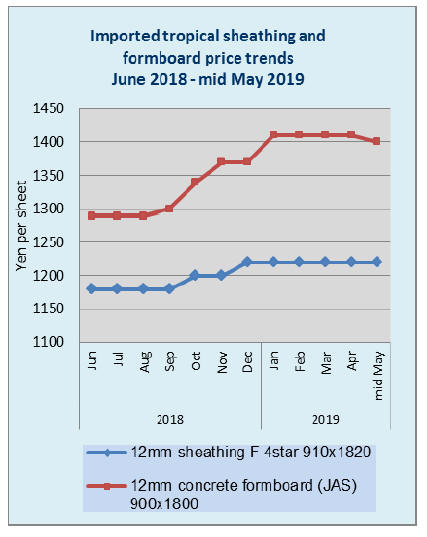
|